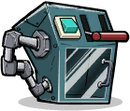Radiant Gas Pipe
Radiant Gas Pipe is a type of Gas Pipe that doubles the thermal conductivity of the material used to construct it, making it useful for heat pumps.
Comparison to Radiant Liquid Pipes
In general, Radiant Gas Pipes are inferior to Radiant Liquid Pipes for heat exchangers.
- Liquid pipes have a throughput of 10kg/s, compared to 1kg/s for gas pipes; this essentially means that even with identical material/coolant properties, a gas pipe will transfer 1/10 the heat.
- Metal Ore has significantly worse thermal properties than Refined Metal. The highest thermal conductivity among metal ores is Aluminum Ore with a TC of 20.5 - less than 2/3 of the lowest TC among refined metals (Lead at 35).
- In general, gases have worse thermal properties than liquids. As heat transfer is determined by the average of the pipe and coolant's thermal conductivity, this largely is irrelevant in face of the differences between pipe materials and pipe throughput.
Despite this, there are several circumstances where gas coolant (especially Hydrogen) may be preferred.
- Gases have no upper temperature limit and thus high-temperature environments (such as anything involving Magma) will not boil coolant and damage pipes.
- The condensation point of Hydrogen is lower than the freezing point of every liquid other than Super Coolant, making it the best choice for extreme low-temperature environments - especially the production of Liquid Oxygen or processing Sour Gas.
- Radiant gas pipes use half as much material as radiant liquid pipes (25kg vs 50kg), making them more useful when conserving materials is more important than the absolute amount of heat transfer.
Thermal Conductivity
Note that the thermal conductivity of the gas pipe is only half of the equation. Heat transfer with non-insulated pipes uses the average thermal conductivity of the pipe and the material inside it. With most gases, this is close to zero; Hydrogen has the highest thermal conductivity of gases with low condensation points, and is generally the most desirable gas coolant outside high-temperature situations. In practice, coolant properties essentially cancel out the multiplicative effect of the radiant pipe.
| Material | Thermal Conductivity of Material | Thermal Conductivity of Radiant Gas Pipe | Thermal Conductivity w/ Hydrogen Coolant |
|---|---|---|---|
| Aluminum Ore | 20.5 | 41 | 20.58 |
| Cobalt ore | 4 | 8 | 4.08 |
| Copper Ore | 4.5 | 9 | 4.58 |
| Gold Amalgam | 2.0 | 4 | 2.08 |
| Iron Ore | 4.0 | 8 | 4.08 |
| Niobium | 54.0 | 108 | 54.08 |
| Pyrite | 4.5 | 9 | 4.58 |
| Steel | 54.0 | 108 | 54.08 |
| Thermium | 220.0 | 440 | 220.08 |
| Wolframite | 15.0 | 30 | 15.08 |


































